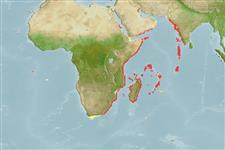Environment: milieu / climate zone / depth range / distribution range
Ecologia
marinhas associadas(os) a recifes; não migratória; intervalo de profundidade 6 - 40 m (Ref. 9710). Tropical
Western Indian Ocean: Somalia to East London, South Africa. Also around oceanic islands. Common off East Africa (Ref. 9710).
Tamanho / Peso / Idade
Maturity: Lm ? range ? - ? cm
Max length : 8.0 cm TL macho/indeterminado; (Ref. 5953)
Descrição suscinta
Chaves de identificação | Morfologia | Morfometria
Head, upper sides, dorsal, and caudal fins golden yellow; lower two-thirds of the body and the anal fin black with numerous close-set purple spots.
Inhabits areas with coral rubble and frequently occurs in small groups of up to about 10 individuals. Feeds on small invertebrates and algae (Ref. 5503). Spawns at sunset; male stimulating the emission of eggs with biting motions on female's abdomen; eggs released and abandoned in open water without any particular parental care (Ref. 5503). Popular aquarium fish in Natal. Occasionally exported from Kenya.
Ciclo de vida ou comportamento de acasalamento
Maturities | Reprodução | Spawnings | Egg(s) | Fecundities | Larvas
Bi-directional sex change has been confirmed for this species (Ref. 103751).
Allen, G.R., 1985. Butterfly and angelfishes of the world. Vol. 2. 3rd edit. in English. Mergus Publishers, Melle, Germany. (Ref. 4858)
Status na Lista Vermelha da UICN (Ref. 130435)
Ameaça para os humanos
Harmless
Uso pelos humanos
Pescarias: sem interesse; Aquário: Espécies comerciais
Ferramentas
Relatórios especiais
Baixar XML
Fontes da internet
Estimates based on models
Preferred temperature (Ref.
123201): 24.6 - 27.8, mean 26.8 °C (based on 84 cells).
Índice de diversidade filogenética (Ref.
82804): PD
50 = 0.5000 [Uniqueness, from 0.5 = low to 2.0 = high].
Bayesian length-weight: a=0.03090 (0.01359 - 0.07026), b=2.89 (2.70 - 3.08), in cm total length, based on LWR estimates for this (Sub)family-body shape (Ref.
93245).
Nível Trófico (Ref.
69278): 2.9 ±0.32 se; based on food items.
Resiliência (Ref.
120179): Elevada, tempo mínimo de duplicação da população menor que 15 meses (Preliminary K or Fecundity.).
Fishing Vulnerability (Ref.
59153): Low vulnerability (10 of 100).
Nutrients (Ref.
124155): Calcium = 125 [61, 193] mg/100g; Iron = 0.772 [0.462, 1.296] mg/100g; Protein = 18.1 [16.9, 19.3] %; Omega3 = 0.126 [0.074, 0.209] g/100g; Selenium = 23.6 [12.5, 44.2] μg/100g; VitaminA = 114 [32, 393] μg/100g; Zinc = 1.86 [1.26, 2.70] mg/100g (wet weight);
